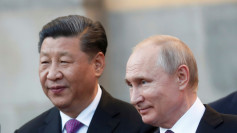Volatile world oil prices continue to yo-yo, this time dipping by 1% per barrel on account of a slight increase in the number of U.S. oil rigs.
The addition of the new rigs, which will bolster the already formidable output of shale oil, is a clear sign the Americans will boost crude output further in defiance of OPEC+, whose members have agreed to slash output to boost prices and prevent an unwanted glut in crude.
High and rising U.S. crude oil production rose to a record 11.9 million barrels per day (bpd) late 2018 and has been softening oil prices to unwanted levels. U.S. crude oil futures stood at $52.84 per barrel Monday, down 85 cents, (1.58%), from their last settlement.
In a sign oil production output will rise further, U.S. drilling firms last week increased the number of rigs looking for new oil for the first time this year. The rig count now stands at 862, or an addition of 10 rigs. The U.S. is now the world's largest oil producer because of its shale oil boom.
Some analysts expect U.S. crude oil prices to range between $50 to $60 per barrel in 2019 and about $10 more per barrel for Brent. They surmise oil prices might be supported above $50 per barrel because it's very clear that Saudi Arabia will no longer be willing to accept these lower oil prices.
On the other hand, some of the world's largest banks at the start of the year expected oil prices to average $70 per barrel. A number projected prices to reach as high as $78 per barrel.
The expected rebound in oil prices to $70 will be about a third higher than the price on Dec. 27, 2018, said a Bloomberg survey of oil analysts. Volatility peaked in the final week of December on account of similar volatility on Wall Street.
Supply and demand no longer drive the oil market's unnerving volatility. The driving forces are well-founded concerns about the slowing growth of the global economy caused by Trump's trade war against the world.
Some banks see oil prices zooming even higher in 2019. The most bullish forecasts came from Morgan Stanley and Standard Chartered Plc, which project Brent to average $78 a barrel in 2019.
On the other hand, Citigroup Inc. believes the relentless growth of U.S. shale production will keep a cap on prices. It predicts that Brent will average $59.50 in 2019 because of the price dampening effect of increased U.S. shale oil production.
In early December, the Organization of Petroleum Exporting Countries (OPEC), and other non-member producers such as Russia, said they will reduce supply by 1.2 million barrels a day in the first half of 2019.
Analysts said the production cut announced by OPEC+ will likely be enough to balance the market in the first half of 2019 and prevent inventories from building.
In addition to the production cut, Saudi Arabia will target the United States with a huge oil export cut. On average, Saudi Arabia exported 860,000 barrels a day of crude to the U.S. so far this year.
But more worrisome for traders is the magnitude of demand growth given the unsettled conditions of the oil market. The global economic slowdown and the trade war between the U.S. and China are depressing fuel demand-growth projections.
Oil consumption will likely average above 100 million bpd for the first time ever in 2019, driven largely by demand from China. This boost will be ephemeral given China's slowing manufacturing sector.
Analysts noted that earnings at China's industrial firms plunged for a second straight month in December 2018 on weak factory activity. This contraction placed more pressure on China, which reported its slowest pace of growth at 6.6 percent last year since 1990.
"Persistent weakness seen in Chinese economic data has raised downside risks ... of lower crude oil imports by Beijing in 2019," said Benjamin Lu of Phillip Futures based in Singapore.
China is trying to turn back the slowdown with aggressive fiscal stimulus measures, which will, however, boost its already massive multi-trillion dollar debt burden.
But there are concerns that these measures may not have the desired effect as China's economy is already laden with massive debt and some of the bigger government spending measures may be of little real use.






